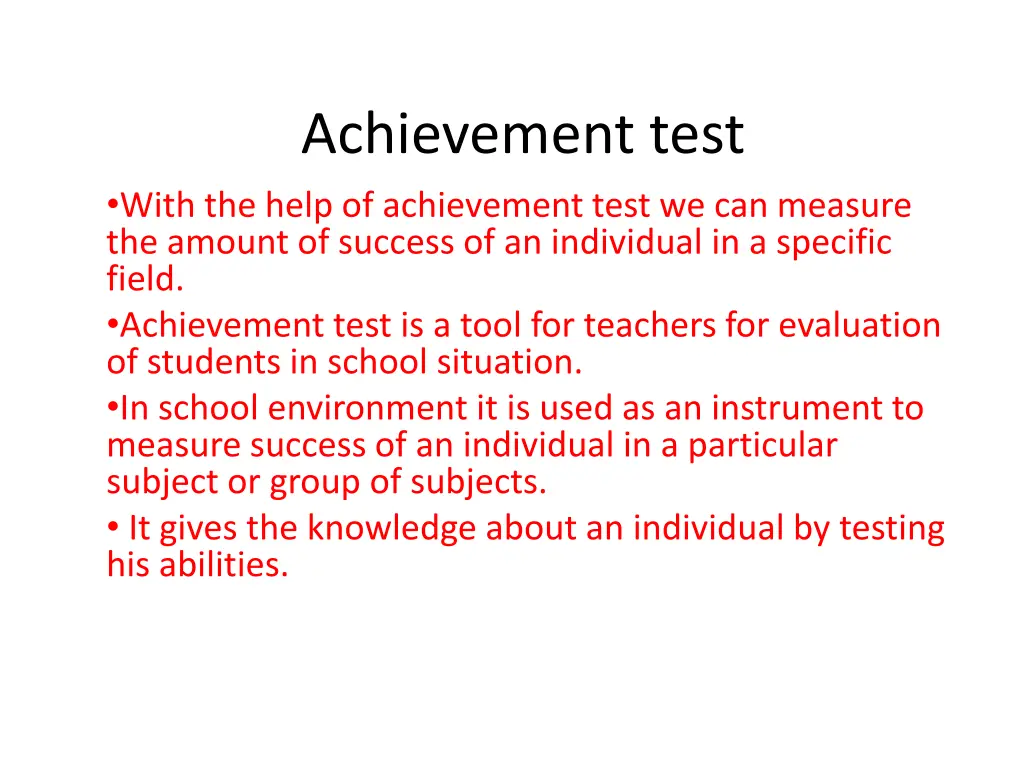
Steps for Constructing an Achievement Test: Planning to Scoring Key
Learn about the systematic process of constructing an achievement test, from planning and drafting to item analysis and establishing reliability and validity. This comprehensive guide explains the key steps involved in creating effective assessment tools for measuring student success in school environments.
Download Presentation

Please find below an Image/Link to download the presentation.
The content on the website is provided AS IS for your information and personal use only. It may not be sold, licensed, or shared on other websites without obtaining consent from the author. If you encounter any issues during the download, it is possible that the publisher has removed the file from their server.
You are allowed to download the files provided on this website for personal or commercial use, subject to the condition that they are used lawfully. All files are the property of their respective owners.
The content on the website is provided AS IS for your information and personal use only. It may not be sold, licensed, or shared on other websites without obtaining consent from the author.
E N D
Presentation Transcript
Achievement test With the help of achievement test we can measure the amount of success of an individual in a specific field. Achievement test is a tool for teachers for evaluation of students in school situation. In school environment it is used as an instrument to measure success of an individual in a particular subject or group of subjects. It gives the knowledge about an individual by testing his abilities.
Questions For constructing an achievement test in any school subject following two questions gives the way; What to measure? It involves certain objectives in view that enable to bring out accepted changes in the students behavior when we teach. How to measure? It involves how to construct an instrument that measures the abilities of students
General steps for constructing an Achievement Test: 1. Planning the test--------- Blueprint a) Designing the test b) Preparation of the 2. Preparing Preliminary Draft------a) Item writing b) Item editing c)Pre- tryout 3. The tryout 4. Item Analysis 5. Preparing the Final Draft 6. Establishment of------- a) Reliability b) Validity c) Norms 7. Construction of the Scoring Key
Planning the test a) Designing the test Weightage to the objectives Weightage to the content Weightage to the form of questions Weightage to difficulty level b) Preparation of the Blueprint
Preparing Preliminary Draft a. Item writing i. Each item contains single idea. ii. Questions should be clear. iii. Simple and easy to understand. iv. Double barreled question should be avoided. v. Arrangement of items should be from simple to complex. vi. Subjective question should also be avoided. b. Item editing c. Pre try out
The try out I. Proper sitting arrangements. II. Time of administrating the test. III. Total time required for test. IV. Proper motivation with the pupil.
Item analysis 1. Estimating Item Difficulty: Difficulty = R/N 100 R Number of pupils who answered the item correctly N Total number of pupils who attempted the item. Item 1 Item 2 Item 3 Item 4 Item 5 D. index 0.375 0.75 0.50 0.15 0.60 2. Estimating Discrimination Index: Discriminating power = RU RL/ N/ 2 RU Number of correct responses from upper group. RL Number of correct responses from lower group. N Total number of pupils who attempted the item.
5. Final draft 6. Establishment of Reliability, Validity and Norms a. Reliability: The reliability of a test measures whatever it measure. b. Validity: It is very important aspect of test and it can be determined as the degree which is capable of measuring achievements and it is design to do so. Valid test is highly reliable c. Norms: age norms, grade norms, percentile norms and standard scores. 7. The Scoring Key
BLUE PRINT A test blueprint is a list of key components defining our test. including:- The purpose of the test The content framework The testing time The content weigh The item formats (e.g., MCQ, essay question)
